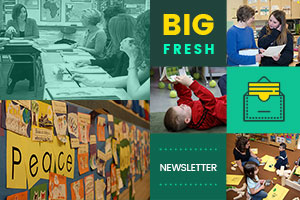The best investment is in the tools of one’s own trade.
—Benjamin Franklin
Tools
My son is working as a conductor trainee for Norfolk Southern. As a gift, we gave him a Milwaukee-branded heated coat. Since trains run in all weather conditions, we knew Sam would appreciate this high-tech coat.
As the weather began to change, Sam became more interested in the coat. He attached the battery, tried it on, and began giving us commentary on the heat. He read the box and the labels, as he continued to narrate the play-by-play of the warmer in the jacket lining.
“Whoa, this is amazing. I have to try it outside.” Sam and the dog went out the back door for a little stargazing.
With this issue of the Big Fresh on my mind, I recognized the coat as a tool Sam needs for his work. I was intrigued by this interest in finding out more about it and how he talked about the way it would make his life better, as well as the other “tools” he would need to keep warm in the winter months.
There are many ways to keep warm in an Indiana winter, and I’m not suggesting that a heated coat is a necessity. It’s simply one possible tool for someone to use.
The same is true for the tools we use in our classrooms to foster independence. This is not a new concept, but what strikes me about this collection of articles is the way contributors are personalizing and noticing opportunities for tools that will help students build their capacity for independence—plus more, as always.
Shine on,
Ruth Ayres
Editor in. Chief

Tara Barnett and Kate Mills give three principles they use to help avoid the “charts as wallpaper” syndrome in their fourth-grade classroom.
Are you looking to connect with other instructional influencers? Join Coach-to-Coach—a free monthly gathering for instructional coaches. You’ll receive an inspiration article from our Leaders Lounge and a Zoom link to learn and collaborate with others. Coach-to-Coach is led by Ruth Ayres. Our next gathering is Wednesday, November 12, at 12:35 p.m. (EST).

New members-only content is added each week to the Choice Literacy website. If you’re not yet a member, click here to explore membership options.
Melissa Quimby tackles the question of how to foster more independence in her students. She examines the way tools can help scaffold independence. Melissa offers an in depth conversation that considers what tool to create, how to introduce it, and where to store it.
Choice Numeracy | Finding a task as rich as The Locker Problem is a bit like finding the perfect read aloud. Jodie Bailey guides us to recognize different ways to turn a seemingly mundane problem into a rich task.
VIDEO | Tammy Mulligan explains her process of using multiple versions of an anchor chart to help students remember and personalize a process for reading nonfiction texts.

New members-only content is added each week to the Choice Literacy website. If you’re not yet a member, click here to explore membership options.
TEACHER EDUCATORS TEACH | We know the importance of nourishing positive reading experiences in our students. Inspired by the insights of her middle school students, Leigh Anne Eck decided to help teacher educators consider ways to support students in becoming stronger readers.
One of the most consistent challenges teachers and leaders face is knowing what to trust during literacy instruction: the practices and resources they are expected to deliver with fidelity, or what they observe while teaching readers and writers. Matt Renwick offers two ways to shift practices: school-wide assessment and instructional walks, as well as guided reflection questions.
Quote It:
How beautifully leaves grow old. How full of light and color are their last days.
—John Burroughs
That’s all for this week!



